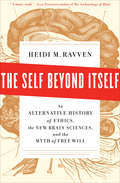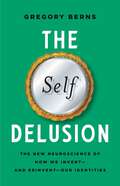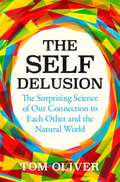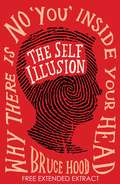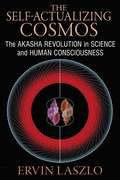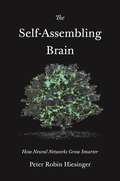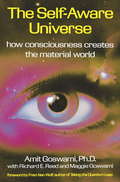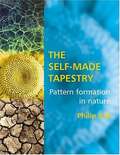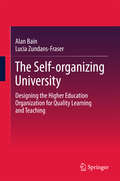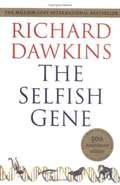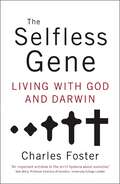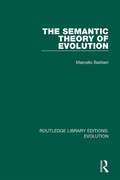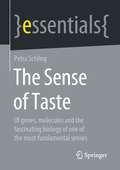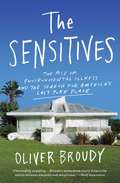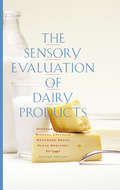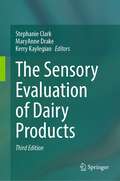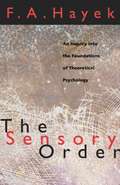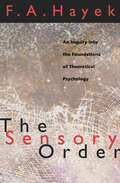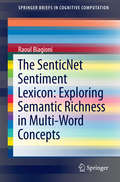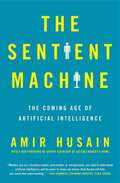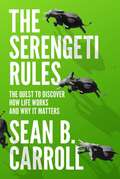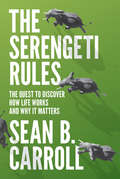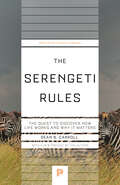- Table View
- List View
The Self Beyond Itself: An Alternative History of Ethics, the New Brain Sciences, and the Myth of Free Will
by Heidi M. Ravven&“Intertwines history, philosophy, and science . . . A powerful challenge to conventional notions of individual responsibility&” (Publishers Weekly). Few concepts are more unshakable in our culture than free will, the idea that individuals are fundamentally in control of the decisions they make, good or bad. And yet the latest research about how the brain functions seems to point in the opposite direction . . . In a work of breathtaking intellectual sweep and erudition, Heidi M. Ravven offers a riveting and accessible review of cutting-edge neuroscientific research into the brain&’s capacity for decision-making—from &“mirror&” neurons and &“self-mapping&” to surprising new understandings of group psychology. The Self Beyond Itself also introduces readers to a rich, alternative philosophical tradition of ethics, rooted in the writing of Baruch Spinoza, that finds uncanny confirmation in modern science. Illustrating the results of today&’s research with real-life examples, taking readers from elementary school classrooms to Nazi concentration camps, Ravven demonstrates that it is possible to build a theory of ethics that doesn&’t rely on free will yet still holds both individuals and groups responsible for the decisions that help create a good society. The Self Beyond Itself is that rare book that injects new ideas into an old debate—and &“an important contribution to the development of our thinking about morality&” (Washington Independent Review of Books). &“An intellectual hand-grenade . . . A magisterial survey of how contemporary neuroscience supports a vision of human morality which puts it squarely on the same plane as other natural phenomena.&” —William D. Casebeer, author of Natural Ethical Facts
The Self Delusion: The New Neuroscience of How We Invent—and Reinvent—Our Identities
by Gregory BernsA New York Times–bestselling author reveals how the stories we tell ourselves, about ourselves, are critical to our lives We all know we tell stories about ourselves. But as psychiatrist and neuroscientist Gregory Berns argues in The Self Delusion, we don&’t just tell stories; we are the stories. Our self-identities are fleeting phenomena, continually reborn as our conscious minds receive, filter, or act on incoming information from the world and our memories. Drawing on new research in neuroscience, social science, and psychiatry, Berns shows how our stories and our self-identities are temporary and therefore ever changing. Berns shows how we can embrace the delusion of a singular self to make our lives better, offering a plan not centered on what we think will be best for us, but predicated on minimizing regrets. Enlightening, empowering, and surprising, The Self Delusion shows us how to be the protagonist of the stories we want to tell.
The Self Delusion: The Surprising Science of Our Connection to Each Other and the Natural World
by Tom Oliver'A thought-provoking and worthwhile read' THE TIMES'A timely, challenging book' GUARDIAN'[A] rich, intriguing book' NATUREWE ARE MUCH MORE CONNECTED TO NATURE AND EACH OTHER THAN WE REALISE . . . - Most of our 37 trillion cells have such a short lifespan that we are essentially made anew every few weeks- The molecules forming our bodies have been component parts of countless other organisms, from ancient plants to dinosaurs- The bacteria, fungi and viruses that make up our bodies influence our moods and even manipulate our behaviour- Every word and every touch we receive from other people transforms the neural networks in our brain and changes our sense of self THE SELF DELUSION is an explosive, powerful and inspiring book that brings together overwhelming evidence against the illusion we have of ourselves as independent beings - and explains how understanding our many connections may be the key to a better future.
The Self Illusion (Extract): Why There is No 'You' Inside Your Head
by Bruce HoodThis is an extended extract from The Self Illusion: Why There is No 'You' Inside Your Head.Most of us believe that we possess a self - an internal individual who resides inside our bodies, making decisions, authoring actions and possessing free will. The feeling that a single, unified, enduring self inhabits the body - the 'me' inside me - is compelling and inescapable. This is how we interact as a social animal and judge each other's actions and deeds. But that sovereignty of the self is increasingly under threat from science as our understanding of the brain advances. Rather than a single entity, the self is really a constellation of mechanisms and experiences that create the illusion of the internal you.We only emerge as a product of those around us as part of the different storylines we inhabit from the cot to the grave. It is an every changing character, created by the brain to provide a coherent interface between the multitude of internal processes and the external world demands that require different selves.
The Self Illusion: Why There is No 'You' Inside Your Head
by Bruce HoodMost of us believe that we possess a self - an internal individual who resides inside our bodies, making decisions, authoring actions and possessing free will. The feeling that a single, unified, enduring self inhabits the body - the 'me' inside me - is compelling and inescapable. This is how we interact as a social animal and judge each other's actions and deeds. But that sovereignty of the self is increasingly under threat from science as our understanding of the brain advances. Rather than a single entity, the self is really a constellation of mechanisms and experiences that create the illusion of the internal you.We only emerge as a product of those around us as part of the different storylines we inhabit from the cot to the grave. It is an ever changing character, created by the brain to provide a coherent interface between the multitude of internal processes and the external world demands that require different selves.
The Self-Actualizing Cosmos: The Akasha Revolution in Science and Human Consciousness
by Ervin LaszloAn exploration of the current revolution in scientific thought and the newest scientific findings in support of the Akashic field • Explains how the new Akasha paradigm recognizes the interconnection of all things in space and time through the quantum resonance of the Akashic field • Reveals the cosmos to be a self-actualizing, self-organizing whole, bringing forth life and consciousness in countless universes • Explores the latest discoveries in the sciences of life, mind, and cosmos Science evolves through alternating phases of “normal science” and radical shifts that create scientific revolutions. We saw this at the turn of the 20th century, when science shifted from a Newtonian worldview to Einstein’s relativity paradigm, and again with the shift to the quantum paradigm. Now, as we recognize the nonlocal interconnection of all things in space and time, we find our scientific worldview shifting once again. With contributions by physicists Paul A. LaViolette and Peter Jakubowski, pioneering systems scientist Ervin Laszlo explores the genesis of the current revolution in scientific thought and the latest findings in support of the Akashic field. He explains how the burgeoning Akasha paradigm returns our way of thinking to an integral consciousness, a nonlinear mode of understanding that enables us to accept the reality of nonlocal interconnection throughout the world. This new inclusive way of understanding reaffirms the age-old instinctive comprehension of deep connections among people, societies, and nature, and it integrates and transcends classical religious and scientific paradigms. Providing examples from cutting-edge science of quantum-resonance-based interactions among all living systems, Laszlo shows the cosmos of the Akasha to be a self-actualizing, self-organizing whole, where each part is in coherence with all others and all parts together create the conditions for the emergence of life and consciousness. The advent of the Akasha paradigm marks a new stage in science’s understanding of the fundamental nature of the world and offers unique guidance for contemporary efforts to create a peaceful and sustainable world.
The Self-Assembling Brain: How Neural Networks Grow Smarter
by Peter Robin HiesingerWhat neurobiology and artificial intelligence tell us about how the brain builds itself How does a neural network become a brain? While neurobiologists investigate how nature accomplishes this feat, computer scientists interested in artificial intelligence strive to achieve this through technology. The Self-Assembling Brain tells the stories of both fields, exploring the historical and modern approaches taken by the scientists pursuing answers to the quandary: What information is necessary to make an intelligent neural network?As Peter Robin Hiesinger argues, “the information problem” underlies both fields, motivating the questions driving forward the frontiers of research. How does genetic information unfold during the years-long process of human brain development—and is there a quicker path to creating human-level artificial intelligence? Is the biological brain just messy hardware, which scientists can improve upon by running learning algorithms on computers? Can AI bypass the evolutionary programming of “grown” networks? Through a series of fictional discussions between researchers across disciplines, complemented by in-depth seminars, Hiesinger explores these tightly linked questions, highlighting the challenges facing scientists, their different disciplinary perspectives and approaches, as well as the common ground shared by those interested in the development of biological brains and AI systems. In the end, Hiesinger contends that the information content of biological and artificial neural networks must unfold in an algorithmic process requiring time and energy. There is no genome and no blueprint that depicts the final product. The self-assembling brain knows no shortcuts.Written for readers interested in advances in neuroscience and artificial intelligence, The Self-Assembling Brain looks at how neural networks grow smarter.
The Self-Aware Universe
by Amit GoswamiConsciousness, not matter, is the ground of all existence, declares University of Oregon physicist Goswami, echoing the mystic sages of his native India. He holds that the universe is self-aware, and that consciousness creates the physical world.
The Self-made Tapestry: Pattern Formation in Nature
by Philip BallA revelatory exploration of nature's magnificent patterns and forms--and of their origins in simple physical law.
The Self-organizing University
by Alan Bain Lucia Zundans-FraserThis book challenges the orthodoxy of learning and teaching in higher education with an original change approach entitled the Self-Organizing University (SOU). It assists universities build a comprehensive model of learning and teaching at whole-of-organization scale. The chapters demonstrate how a Self-Organizing University can create: * measurable learning and teaching standards; * student centered program development; * enhanced faculty professional growth and career trajectory; * more efficient and effective organizational design; * better feedback; * powerful use of technologies; * a legitimate connection between quality and productivity. Each chapter includes case examples derived from practical experience that situate the key ideas and concepts in the real day-to-day work of universities. The role of leadership in creating and sustaining a self-organizing university is also a key focus. The chapters target leadership practices that improve learning and teaching quality and productivity and assist universities realize their goals and aspirations for maximizing student learning.
The Selfish Gene
by Richard Dawkins"The Selfish Gene" caused a wave of excitement among biologists and the general public when it was first published in 1976. Its vivid rendering of a gene's eye view of life, in lucid prose, gathered together the strands of thought about the nature of natural selection into a conceptual framework with far-reaching implications for our understanding of evolution. Time has confirmed its significance. Intellectually rigorous, yet written in non-technical language, "The Selfish Gene" is widely regarded as a masterpiece of science writing, and its insights remain as relevant today as on the day it was published.
The Selfless Gene: Living with God and Darwin
by Charles FosterIf evolutionary theory is correct, what does that say about creator God?Ever since the famous debate on Darwinism between Huxley and Wilberforce in 1860, there has been little real conversation between the scientific community and much of the Christian world. This book offers the prospect of reconciliation between what are seen as two opposing worldviews.With remarkable insight and skill, Foster shows that most evolutionary theory and its consequences are easily reconciled with Christian orthodoxy and explores the ethical problems of natural selection in a fresh and invigorating way.Charles Foster insists on getting to the heart of the topic and succeeds through a scientific and biblical analysis that is second to none. The Selfless Gene has the potential to become required reading for theologians and laypeople alike.
The Semantic Theory of Evolution (Routledge Library Editions: Evolution #1)
by Marcello BarbieriOriginally published in 1985, The Semantic Theory of Evolution addresses the notion that life is not shaped by the single law of natural selection, but instead by a plurality of laws that resemble grammatical rules in language. This remarkable work presents a semantic theory centering on the concept of the ribotype. Supported by both sound facts and logical arguments, this analysis reaches beyond the established cadre of biological thought to unravel many of life’s mysteries and paradoxes, including the origin of the cell and the nucleus and the evolution of ribosomes.
The Sense of Taste: Of genes, molecules and the fascinating biology of one of the most fundamental senses (essentials)
by Petra SchlingIn this essential, Petra Schling gives an overview of the current state of research on the topic of taste. She regards taste as a sensory perception that allows us to distinguish essential food components from toxins. What we eat depends not insignificantly on how we like it. But how do we actually taste - and what do we taste? As omnivores, we humans have a relatively wide range of taste receptors, not only in our mouths, which provide us with important information about our food. Outside the mouth, taste receptors serve our innate immune system to "taste" bacteria, worms and other intruders. We can and should rely on this. Our sense of taste warns us of toxins and unwanted co-inhabitants and can only be deceived to a very limited extent by sweeteners, bitter blockers or similar tricks.This Springer essential is a translation of the original German 1st edition essentials,Der Geschmack by Petra Schling, published by Springer Fachmedien Wiesbaden GmbH, part of Springer Nature in 2021.The translation was done with the help of artificial intelligence (machine translation by the service DeepL.com). A subsequent human revision was done primarily in terms of content, so that the book will read stylistically differently from a conventional translation. Springer Nature works continuously to further the development of tools for the production of books and on the related technologies to support the authors.
The Sensitives: The Rise of Environmental Illness and the Search for America's Last Pure Place
by Oliver BroudyA compelling exploration of the mysteries of environmental toxicity and the community of &“sensitives&”—people with powerful, puzzling symptoms resulting from exposure to chemicals, fragrances, and cell phone signals, that have no effect on &“normals.&”They call themselves &“sensitives.&” Over fifty million Americans endure a mysterious environmental illness that renders them allergic to chemicals. Innocuous staples from deodorant to garbage bags wreak havoc on sensitives. For them, the enemy is modernity itself. No one is born with EI. It often starts with a single toxic exposure. Then the symptoms hit: extreme fatigue, brain fog, muscle aches, inability to tolerate certain foods. With over 85,000 chemicals in the environment, danger lurks around every corner. Largely ignored by the medical establishment and dismissed by family and friends, sensitives often resort to odd ersatz remedies, like lining their walls with aluminum foil or hanging mail on a clothesline for days so it can &“off-gas&” before they open it. Broudy encounters Brian Welsh, a prominent figure in the EI community, and quickly becomes fascinated by his plight. When Brian goes missing, Broudy travels with James, an eager, trusting sensitive to find Brian, investigate this disease, and delve into the intricate, ardent subculture that surrounds it. Their destination: Snowflake, the capital of the EI world. Located in eastern Arizona, it is a haven where sensitives can live openly without fear of toxins or the judgment of insensitive &“normals.&” While Broudy&’s book is wry, pacey, and down-to-earth, it also dives deeply into compelling corners of medical and American history. He finds telling parallels between sensitives and their cultural forebears, from the Puritans to those refugees and dreamers who settled the West. Ousted from mainstream society, these latter-day exiles nonetheless shed bright light on the anxious, noxious world we all inhabit now.
The Sensory Accommodation Framework for Technology: Bridging Sensory Processing to Social Cognition (Synthesis Lectures on Technology and Health)
by LouAnne BoydThis book provides a thorough introduction to the many facets of designing technologies for autism, with a particular focus on optimizing visual attention frameworks. This book is designed to provide a detailed overview of several aspects of technology for autism. Each Chapter illustrates different parts of the Sensory Accommodation Framework and provides examples of relevant available technologies. The books first discusses a variety of skills that make up human development as well as a history of autism as a diagnosis and the birth of the neurodiversity movement. It goes on to detail individual types of therapy and how they interact with autism. The systems involved in sensory processing and their specific relation to autism are then explored, including through technologies that have addressed these areas and applications for designers. Readers will learn about designing sensory environments and sensory interactions, such as through virtual reality. This book places a needed emphasis on the hierarchy of information in technology development by exploring visual attention in neurodivergent conditions like autism, ADHD, and dyslexia. It also delves into the relationship between sensory perception and nonverbal communication, the bridge between sensory input and social behavior, and dynamic information. The discussion is rounded out with examinations of temporal processing as and multisensory integration as complicating factors that have existing technological solutions. Finally, the book closes with a summary of the sensory accommodation framework in respect to how each layer offers different user experience goals and specific mechanisms to promote those goals. Readers from a variety of research backgrounds will find this book informative and useful, while designers will learn essential skills for effectively designing autism technologies.
The Sensory Evaluation of Dairy Products
by Stephanie Clark Floyd Bodyfelt Maryanne Drake Michael CostelloThe Sensory Evaluation of Dairy Products, Second Edition is for all who seek a book entirely devoted to sensory evaluation of dairy products and modern applications of the science. It is an excellent scientific reference for training in dairy product evaluation and is a practical guide to the preparation of samples for sensory evaluation. The book contains updates of the original text of the well-received first edition, as well as brand new material. This unique book is designed for professionals involved in many aspects of dairy production, including academic teaching and research, processing, quality assurance, product development and marketing. It is an invaluable tool for those who compete in the annual Collegiate Dairy Product Evaluation Contest.
The Sensory Evaluation of Dairy Products
by Stephanie Clark MaryAnne Drake Kerry KaylegianThe Sensory Evaluation of Dairy Products, Third Edition is for all who seek a book entirely devoted to sensory evaluation of dairy products and modern applications of the science. It is an excellent scientific reference for training in dairy product evaluation and is a practical guide to the preparation of samples for sensory evaluation. The book contains updates of the original text of the well-received first edition, as well as brand new material. This unique book is designed for professionals involved in many aspects of dairy production, including academic teaching and research, processing, quality assurance, product development and marketing. It is an invaluable tool for those who compete in the annual Collegiate Dairy Product Evaluation Contest.
The Sensory Order
by F. A. HayekThe Sensory Order, first published in 1952, sets forth F. A. Hayek's classic theory of mind in which he describes the mental mechanism that classifies perceptions that cannot be accounted for by physical laws. Hayek's substantial contribution to theoretical psychology has been addressed in the work of Thomas Szasz, Gerald Edelman, and Joaquin Fuster. "A most encouraging example of a sustained attempt to bring together information, inference, and hypothesis in the several fields of biology, psychology, and philosophy."--Quarterly Review of Biology F. A. Hayek (1899-1992), recipient of the Medal of Freedom in 1991 and co-winner of the Nobel Memorial Prize in Economics in 1974, taught at the University of London, the University of Chicago, and the University of Freiburg.
The Sensory Order: An Inquiry into the Foundations of Theoretical Psychology
by F. A. HayekThe Nobel Prize-winning economist explores how the mind works—an early landmark in the field of cognitive science. The Sensory Order, first published in 1952, sets forth F. A. Hayek's classic theory of mind in which he describes the mental mechanism that classifies perceptions that cannot be accounted for by physical laws. Though Hayek is more commonly known as an icon in the field of economics, his genius was wide-ranging—and his contribution to theoretical psychology is of continuing significance to cognitive scientists as well as to economists interested in the interplay between psychology and market systems, and has been addressed in the work of Thomas Szasz, Gerald Edelman, and Joaquin Fuster. &“A most encouraging example of a sustained attempt to bring together information, inference, and hypothesis in the several fields of biology, psychology, and philosophy.&”—Quarterly Review of Biology
The SenticNet Sentiment Lexicon: Exploring Semantic Richness in Multi-Word Concepts
by Raoul BiagioniThe research and its outcomes presented in this book, is about lexicon-based sentiment analysis. It uses single-, and multi-word concepts from the SenticNet sentiment lexicon as the source of sentiment information for the purpose of sentiment classification. In 6 chapters the book sheds light on the comparison of sentiment classification accuracy between single-word and multi-word concepts, for which a bespoke sentiment analysis system developed by the author was used. This book will be of interest to students, educators and researchers in the field of Sentic Computing.
The Sentient Machine: The Coming Age of Artificial Intelligence
by Amir Husain&“A must-read for anyone looking to understand how artificial intelligence is poised to transform human society and life.&” —Paul Scharre, Author of Four Battlegrounds: Power in the Age of Artificial Intelligence The future is now. Acclaimed technologist and inventor Amir Husain explains how we can live amidst the coming age of sentient machines and artificial intelligence—and not only survive, but thrive.Artificial &“machine&” intelligence is playing an ever-greater role in our society. We are already using cruise control in our cars, automatic checkout at the drugstore, and are unable to live without our smartphones. The discussion around AI is polarized; people think either machines will solve all problems for everyone, or they will lead us down a dark, dystopian path into total human irrelevance. Regardless of what you believe, the idea that we might bring forth intelligent creation can be intrinsically frightening. But what if our greatest role as humans so far is that of creators? Amir Husain, a brilliant inventor and computer scientist, argues that we are on the cusp of writing our next, and greatest, creation myth. It is the dawn of a new form of intellectual diversity, one that we need to embrace in order to advance the state of the art in many critical fields, including security, resource management, finance, and energy. &“In The Sentient Machine, Husain prepares us for a brighter future; not with hyperbole about right and wrong, but with serious arguments about risk and potential&” (Dr. Greg Hyslop, Chief Technology Officer, The Boeing Company). He addresses broad existential questions surrounding the coming of AI: Why are we valuable? What can we create in this world? How are we intelligent? What constitutes progress for us? And how might we fail to progress? Husain boils down complex computer science and AI concepts into clear, plainspoken language and draws from a wide variety of cultural and historical references to illustrate his points. Ultimately, Husain challenges many of our societal norms and upends assumptions we hold about &“the good life.&”
The Serengeti Rules
by Sean B. CarrollHow does life work? How does nature produce the right numbers of zebras and lions on the African savanna, or fish in the ocean? How do our bodies produce the right numbers of cells in our organs and bloodstream? In The Serengeti Rules, award-winning biologist and author Sean Carroll tells the stories of the pioneering scientists who sought the answers to such simple yet profoundly important questions, and shows how their discoveries matter for our health and the health of the planet we depend upon.One of the most important revelations about the natural world is that everything is regulated--there are rules that regulate the amount of every molecule in our bodies and rules that govern the numbers of every animal and plant in the wild. And the most surprising revelation about the rules that regulate life at such different scales is that they are remarkably similar--there is a common underlying logic of life. Carroll recounts how our deep knowledge of the rules and logic of the human body has spurred the advent of revolutionary life-saving medicines, and makes the compelling case that it is now time to use the Serengeti Rules to heal our ailing planet.A bold and inspiring synthesis by one of our most accomplished biologists and gifted storytellers, The Serengeti Rules is the first book to illuminate how life works at vastly different scales. Read it and you will never look at the world the same way again.
The Serengeti Rules: The Quest to Discover How Life Works and Why It Matters
by Sean B. CarrollHow does life work? How does nature produce the right numbers of zebras and lions on the African savanna, or fish in the ocean? How do our bodies produce the right numbers of cells in our organs and bloodstream? In The Serengeti Rules, award-winning biologist and author Sean Carroll tells the stories of the pioneering scientists who sought the answers to such simple yet profoundly important questions, and shows how their discoveries matter for our health and the health of the planet we depend upon.One of the most important revelations about the natural world is that everything is regulated—there are rules that regulate the amount of every molecule in our bodies and rules that govern the numbers of every animal and plant in the wild. And the most surprising revelation about the rules that regulate life at such different scales is that they are remarkably similar—there is a common underlying logic of life. Carroll recounts how our deep knowledge of the rules and logic of the human body has spurred the advent of revolutionary life-saving medicines, and makes the compelling case that it is now time to use the Serengeti Rules to heal our ailing planet.A bold and inspiring synthesis by one of our most accomplished biologists and gifted storytellers, The Serengeti Rules is the first book to illuminate how life works at vastly different scales. Read it and you will never look at the world the same way again.
The Serengeti Rules: The Quest to Discover How Life Works and Why It Matters (Princeton Science Library #151)
by Sean B. CarrollOne of today's most accomplished biologists and gifted storytellers reveals the rules that regulate all lifeHow does life work? How does nature produce the right numbers of zebras and lions on the African savanna, or fish in the ocean? How do our bodies produce the right numbers of cells in our organs and bloodstream? In The Serengeti Rules, award-winning biologist and author Sean Carroll tells the stories of the pioneering scientists who sought the answers to such simple yet profoundly important questions, and shows how their discoveries matter for our health and the health of the planet we depend upon.One of the most important revelations about the natural world is that everything is regulated—there are rules that regulate the amount of every molecule in our bodies and rules that govern the numbers of every animal and plant in the wild. And the most surprising revelation about the rules that regulate life at such different scales is that they are remarkably similar—there is a common underlying logic of life. Carroll recounts how our deep knowledge of the rules and logic of the human body has spurred the advent of revolutionary life-saving medicines, and makes the compelling case that it is now time to use the Serengeti Rules to heal our ailing planet.Bold and inspiring, The Serengeti Rules illuminates how life works at vastly different scales. Read it and you will never look at the world the same way again.
